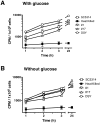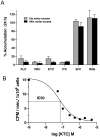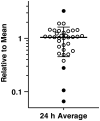Azole drugs are imported by facilitated diffusion in Candida albicans and other pathogenic fungi
- PMID: 20941354
- PMCID: PMC2947996
- DOI: 10.1371/journal.ppat.1001126
Azole drugs are imported by facilitated diffusion in Candida albicans and other pathogenic fungi
Abstract
Despite the wealth of knowledge regarding the mechanisms of action and the mechanisms of resistance to azole antifungals, very little is known about how the azoles are imported into pathogenic fungal cells. Here the in-vitro accumulation and import of Fluconazole (FLC) was examined in the pathogenic fungus, Candida albicans. In energized cells, FLC accumulation correlates inversely with expression of ATP-dependent efflux pumps. In de-energized cells, all strains accumulate FLC, suggesting that FLC import is not ATP-dependent. The kinetics of import in de-energized cells displays saturation kinetics with a K(m) of 0.64 μM and V(max) of 0.0056 pmol/min/10⁸ cells, demonstrating that FLC import proceeds via facilitated diffusion through a transporter rather than passive diffusion. Other azoles inhibit FLC import on a mole/mole basis, suggesting that all azoles utilize the same facilitated diffusion mechanism. An analysis of related compounds indicates that competition for azole import depends on an aromatic ring and an imidazole or triazole ring together in one molecule. Import of FLC by facilitated diffusion is observed in other fungi, including Cryptococcus neoformans, Saccharomyces cerevisiae, and Candida krusei, indicating that the mechanism of transport is conserved among fungal species. FLC import was shown to vary among Candida albicans resistant clinical isolates, suggesting that altered facilitated diffusion may be a previously uncharacterized mechanism of resistance to azole drugs.
Conflict of interest statement
The authors have declared that no competing interests exist.
Figures






Similar articles
-
Azole drug import into the pathogenic fungus Aspergillus fumigatus.Antimicrob Agents Chemother. 2015;59(6):3390-8. doi: 10.1128/AAC.05003-14. Epub 2015 Mar 30. Antimicrob Agents Chemother. 2015. PMID: 25824209 Free PMC article.
-
ABC transporter Cdr1p contributes more than Cdr2p does to fluconazole efflux in fluconazole-resistant Candida albicans clinical isolates.Antimicrob Agents Chemother. 2008 Nov;52(11):3851-62. doi: 10.1128/AAC.00463-08. Epub 2008 Aug 18. Antimicrob Agents Chemother. 2008. PMID: 18710914 Free PMC article.
-
The monoamine oxidase A inhibitor clorgyline is a broad-spectrum inhibitor of fungal ABC and MFS transporter efflux pump activities which reverses the azole resistance of Candida albicans and Candida glabrata clinical isolates.Antimicrob Agents Chemother. 2012 Mar;56(3):1508-15. doi: 10.1128/AAC.05706-11. Epub 2011 Dec 27. Antimicrob Agents Chemother. 2012. PMID: 22203607 Free PMC article.
-
Antifungal drug resistance in pathogenic fungi.Med Mycol. 1998;36 Suppl 1:119-28. Med Mycol. 1998. PMID: 9988500 Review.
-
Resistance in human pathogenic yeasts and filamentous fungi: prevalence, underlying molecular mechanisms and link to the use of antifungals in humans and the environment.Dan Med J. 2016 Oct;63(10):B5288. Dan Med J. 2016. PMID: 27697142 Review.
Cited by
-
Community participation in biofilm matrix assembly and function.Proc Natl Acad Sci U S A. 2015 Mar 31;112(13):4092-7. doi: 10.1073/pnas.1421437112. Epub 2015 Mar 13. Proc Natl Acad Sci U S A. 2015. PMID: 25770218 Free PMC article.
-
Candida albicans flu1-mediated efflux of salivary histatin 5 reduces its cytosolic concentration and fungicidal activity.Antimicrob Agents Chemother. 2013 Apr;57(4):1832-9. doi: 10.1128/AAC.02295-12. Epub 2013 Feb 4. Antimicrob Agents Chemother. 2013. PMID: 23380720 Free PMC article.
-
Interface of Candida albicans biofilm matrix-associated drug resistance and cell wall integrity regulation.Eukaryot Cell. 2011 Dec;10(12):1660-9. doi: 10.1128/EC.05126-11. Epub 2011 Jun 10. Eukaryot Cell. 2011. PMID: 21666076 Free PMC article.
-
Opportunistic yeast pathogens: reservoirs, virulence mechanisms, and therapeutic strategies.Cell Mol Life Sci. 2015 Jun;72(12):2261-87. doi: 10.1007/s00018-015-1860-z. Epub 2015 Feb 21. Cell Mol Life Sci. 2015. PMID: 25700837 Free PMC article. Review.
-
Suppressed Protein Translation Caused by MSP-8 Deficiency Determines Fungal Multidrug Resistance with Fitness Cost.Adv Sci (Weinh). 2025 Feb;12(6):e2412514. doi: 10.1002/advs.202412514. Epub 2024 Dec 16. Adv Sci (Weinh). 2025. PMID: 39679802 Free PMC article.
References
-
- Lai CC, Tan CK, Huang YT, Shao PL, Hsueh PR. Current challenges in the management of invasive fungal infections. J Infect Chemother. 2008;14:77–85. - PubMed
-
- Picazo JJ, Gonzalez-Romo F, Candel FJ. Candidemia in the critically ill patient. Int J Antimicrob Agents. 2008;32(Suppl 2):S83–85. - PubMed
-
- Clark TA, Hajjeh RA. Recent trends in the epidemiology of invasive mycoses. Curr Opin Infect Dis. 2002;15:569–574. - PubMed
-
- Tortorano AM, Kibbler C, Peman J, Bernhardt H, Klingspor L, et al. Candidaemia in Europe: epidemiology and resistance. Int J Antimicrob Agents. 2006;27:359–366. - PubMed
-
- Greenspan D, Greenspan J, Schiodt M, Pindborg J. Copenhagen: Munksgaard; 1990. AIDS and the mouth. pp. 91–102.
Publication types
MeSH terms
Substances
Grants and funding
LinkOut - more resources
Full Text Sources
Other Literature Sources
Medical

